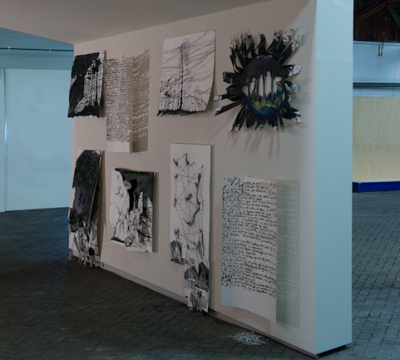marjolijn van den assem
Van den Assem’s work shows itself as travel via seismographic drawings. It’s not about her looks to get a realistic view of what the eye, but she let her hand the reasoning – the denkweg – imagining. Her imaginary journeys often have their origin in the letters of Friedrich Nietzsche. Her work is included in many Dutch museums, including the Rijksmuseum Amsterdam, and in corporate and private collections.
Award
In the ranking of “The Best 100 Dutch artists” stood Marjolein van den Assem according Elsevier (May 6, 2006, No. 18) at the 70th place. In 2012 she received the Lifetime Achievement Award “Brilliants artist of the year ‘(Foundation for Art Week).
Drawing in the language of the thawing-wind
Although she is highly unlikely to be convinced of it herself, few people are as privileged as artist Marjolijn van den Assem. That is because Van den Assem knows what she is looking for (which by no means ensures her finding it). How many spend their lives afloat in a whirlpool of desires, feelings, events, without knowing what they want, which compass to sail by and who might help them to do so?
Not Van den Assem (1947). She found her path thirty-five years ago. During her twenties, she immerses herself in dozens of philosophers and writers, because she, as she puts it, ‘didn’t quite know how to live’. It is constant doubt. But then she receives Ecce Homo as a gift, the tormented self-portrait, written by German philosopher, language virtuoso and poet Friedrich Nietzsche in 1888, before his final descent into madness. Van den Assem becomes hooked on the philosopher. Because of his courage, the enormous mental leaps, the conflict, confusion and contradiction he allows into his thinking. And also because of the defiance: the constant inner dispute of each newly acquired certainty.
In her studio the well-thumbed copies lie piled up and opened — notes in the margins. Van den Assem may have developed into a serious Nietzsche connoisseur, but she is no scientist. She’s far too much of an artist for that. She looks for something else in his writings. She travels after Nietzsche. From Naumburg to Nice, from Leipzig to Genoa and Turin, from the Swiss Sils Maria to Sorrento, south of Naples. She picks the flowers that grow along Nietzsche’s path, dries them, takes them home, to the foot of the Van Brienenoord Bridge. Like Nietzsche, she dives into the heavy current of the Saale in Naumburg and wrestles her way across. She traces his path, his lovers, the women who fell for him. Did Nietzsche view the landscape thus? And how was it shaped in his thinking? At home, she translates it all into drawings — part abstract, part figurative.
Sentences from Nietzsche’s writings surface, never to leave her again. They are lines so mysterious and mesmerising, that they are ‘lived’, as well as drawn, through and through. What does something look like, that has been written ‘in the language of the thawing-wind’? How do you depict Zarathustra when he says (in Thus spoke Zarathustra):
‘I drink once more into myself the flames that break forth from me.’ How does one portray the contradictory and yet so accurate line: ‘Precisely between what is most similar, illusion lies most beautifully; for the smallest cleft is the hardest to bridge’ (from Thus spoke Zarathustra)?
Van den Assem attempts it again each day, on the floor of her studio. Using pastels, East-Indian Ink, dip pen and occasionally a razor sharp Japanese Stanley knife, she gets to work. She chews the paper, sometimes — as she describes it — pulls the image off, she cuts, tears, hammers, her hand swings and slaps. In the morning she doesn’t know where the afternoon will take her.
‘Nietzsche joins me in my work,’ she calls it. ‘At times it’s as though he remembers my handwriting.’
Now, that handwriting has arrived in a specially constructed pavilion in the Noletloodsen. Three hundred tiny, constantly slightly differing drawings hang across from eight larger drawings. The small drawings form the basic, minimalist installation lettre/Brief/letter/brief (2015). The large drawings — a selection of a still growing series — serve as a lyrical counterpart and bear the title brevis libellus (2015-2016), literally meaning ‘short writing’. They form a reaction, only to one letter: a letter written in 1802 by German lyrical poet Friedrich Hölderlin, Nietzsche’s favourite poet. In 1802 Hölderlin, consumed with heartache and in a state of utter despair, returns on foot from Bordeaux, where he holds a position as a private tutor, to the North, to Germany. Along the way, he describes in a letter to a friend an ‘iron sky’, but also the beauty of an efflorescent landscape. Van den Assem copies this letter — monomaniacally, in dip pen, an exercise in acquaintance, art and in serenity.
Hölderlin ends his letter with a desperate plea for a response: ‘I crave the purity of your tone’. Those ‘pure tones’ come from Nietzsche himself — or so they do in the work of Van den Assem. Eighty-five years later — in 1888 — the philosopher writes back and a fictitious correspondence ensues within a single letter. During the 325th transcript of Hölderlin’s letter, Nietzsche’s words from Ecce Homo creep onto the paper. ‘Something unstilled, unstillable is in me, that yearns to make itself heard,’ Nietzsche writes. And that is the essence of being an artist.


